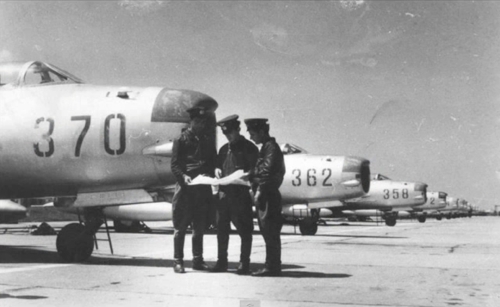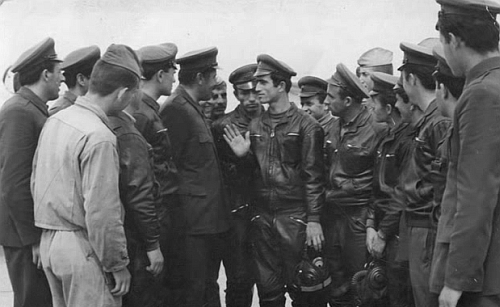|
|
 |
 |
|
Albanian People's Army – History of Air Force Command
|
 |
|
 |
 |
 |
|
Albania in the Soviet Sphere:
Albania became dependent on Soviet aid and know-how after the break with Yugoslavia in 1948. In February 1949, Albania gained membership in the communist bloc's organization for coordinating economic planning, the Council for Mutual Economic Assistance (Comecon). Tirana soon entered into trade agreements with Poland, Czechoslovakia, Hungary, Romania, and the Soviet Union. Soviet and East European technical advisers took up residence in Albania, and the Soviet Union also sent Albania military advisers and built a submarine installation on Sazan Island. After the Soviet-Yugoslav split, Albania and Bulgaria were the only countries that the Soviet Union could use to funnel war material to the communists fighting in Greece. What little strategic value Albania offered the Soviet Union, however, gradually shrank as nuclear arms technology developed.
Early Air Force Days:
The Forcat Ajrore Shqiptare (FAS – Albanian Air Force) was Established at Lapraka airfield on the outskirts of the country’s capital, Tirana, on April 24, 1951. The base had originally been built by the Italians during World War Two.
Initially operating propeller-driven aircraft of Russian origin, such as the Yak-9 and Po-2, the Albanian Air Force entered the jet era in February 1955 with the delivery of MiG-15bis fighters and MiG-15UTI two-seaters. The MiG-15s arrived by ship at the port Durras, the remainder being delivered to the same location three months later. Following assembly by Soviet technicians at Tirana, the first flight of a MiG-15bis in Albania took place on April 7, 1955, with a flypast in public over the capital on May 1.
|
|
|
|
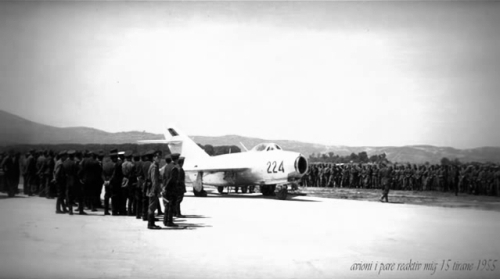 |
|
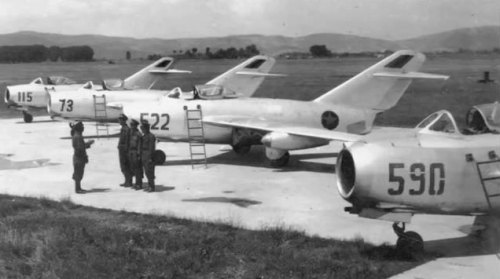 |
 |
 |
|
Unique within the Albanian Air Force is a single Ilyushin IL-28 Beagle. Apart from being the country’s dedicated jet bomber, it was also the first aircraft in Albanian service fitted with radar. The initial example Arrived in 1957 and was Russian-built, being delivered from Riga via Lvov, Budapest, Kucova and finally arriving at Rinas on February 23 that year. The Soviet ferry crew remained in the country to train the Albanian crews prior to returning to the USSR in October. In Albanian Air Force service, the IL-28 was operated in the bomber role.
For transport duties, an Il-14 Create were delivered in 1957. The developing Albanian Air Force received its first rotary-wing equipment in 1957 in the form if three Mil Mi-1 Hares and four Mil Mi-4 Hounds with three further examples of the latter arriving a year.
In October 1959, the Albanian Air Force joined the Mach 1 ‘Club’ when is receive a dozen Soviet-supplied MiG-19PM Farmer interceptors. Equipped for limited all-weather operations, these twin-jet aircraft were also supplied with RS-2US (AA-1 Alkali) ait-to-air missiles, another ‘first’ for the Service. Albania's air defense were strengthened with SA-75 Dvina anti-aircraft missile battalion parallel to the MiG-19PM interceptors, which were subject to a separate air defense command.
|
 |
 |
|
Albanian Air Force Command - Order of Battle in 1960
|
 |
|
|
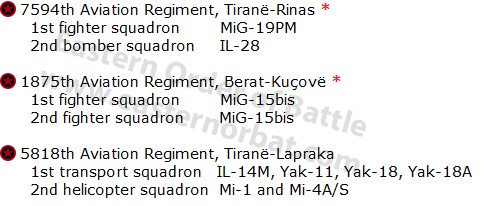 |
 |
 |
|
Albania in the Chinese Sphere:
Albania played a role in the Sino-Soviet conflict far outweighing either its size or its importance in the communist world. By 1958 Albania stood with the People's Republic of China opposing Moscow on issues of peaceful coexistence, de-Stalinization, and Yugoslavia's "separate road to socialism" through decentralization of economic life. But despite these gestures, Tirana was dissatisfied with Moscow's economic policy toward Albania. Hoxha and Shehu apparently decided in May or June 1960 that Albania was assured of Chinese support, and when sharp polemics erupted between the PRC and the Soviet Union, they openly sided with the former.
After additional sharp exchanges between Soviet and Chinese delegates over Albania at the Communist Party of the Soviet Union's Twenty-Second Party Congress in October 1961, Khrushchev lambasted the Albanians for executing a pregnant, pro-Soviet member of the Albanian party Politburo Liri Gega, and the Soviet Union finally broke diplomatic relations with Albania in December. Moscow then withdrew all Soviet economic advisers and technicians from the country and halted shipments of supplies and spare parts for equipment already in place in Albania. In addition, the Soviet Union continued to dismantle its naval installations on Sazan Island, a process that had begun even before the break in relations.
Communist China again compensated Albania for the loss of Soviet economic support, supplying about 90% of the parts, foodstuffs, and other goods the Soviet Union had promised. Beijing lent the Albanians money on more favorable terms than Moscow, and, unlike Soviet advisers, Chinese technicians earned the same low pay as Albanian workers and lived in similar housing.
|
|
|
 |
 |
|
Albanian Air Force in 1973
|
|
|
|
|
Albanian Air Force in 1978
|
|
|
|
 |
 |
|
Tags:
Albania, Albanian Air Force, Forcat Ajrore Shqiptare, FAS, Cold War, Soviet, Chinese, Sino-Soviet conflict, 7594th Aviation Regimen, Tiranë-Lapraka, 1875th Aviation Regiment, Tiranë-Rinas, 5818th Aviation Regiment, Berat-Kuçovë, Yak-9, Po-2, MiG-15bis, Ilyushin IL-28 Beagle, Il-14 Create, MiG-19PM Farmer, interceptor, Mach 1, Mil Mi-1 Hare, Mil Mi-4A Hound, Mi-4S, RS2-US, AA-1 Alkali, SA-75 Dvina, Yak-18A, Yak-11
|
|




